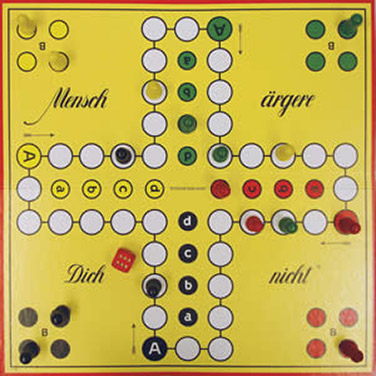Ludo

In this popular board game, each player has to move their four pieces from the start to the finish by completing a circuit of the cross-shaped board. The number of spaces which can be moved each go is decided by the throw of a die. If a player lands on an opponent’s piece, he or she can send it back to the start.
History
The German version of Ludo, "Mensch ärgere dich nicht", was invented by Munich-born Josef Friedrich Schmidt and launched on the German market in 1914. As the game was fairly unsuccessful in the early days, Schmidt gave away 3,000 games to German military hospitals during the First World War. After the war, the soldiers brought the game home, where it took German living rooms by storm.
However, the game's roots date back much further. It is based on the Indian game "Pachisi", the origin of which is unclear, although it is first documented in India in the sixteenth century. English travellers brought the game to Europe in the 1800s. Numerous, sometimes simplified versions of the game were published in the second half of the nineteenth century, including "Ludo" and "Eile mit Weile", which is still highly popular in Switzerland to this day.
Mathematics
Despite its simplicity, Ludo is not a pure game of chance. In the course of a game, the players can actively determine which pieces they move, making their decisions based on complete information. The dominant influence of chance stems from the dice. For the model of an ideal throw, the assumption is that the probability of rolling a one, two etc. is one in six and that the independence of the results applies for several throws. The question as to how long on average a piece needs to cover a certain distance in this straightforward game is complex as the pieces can take each other and send the opponent back to the start.